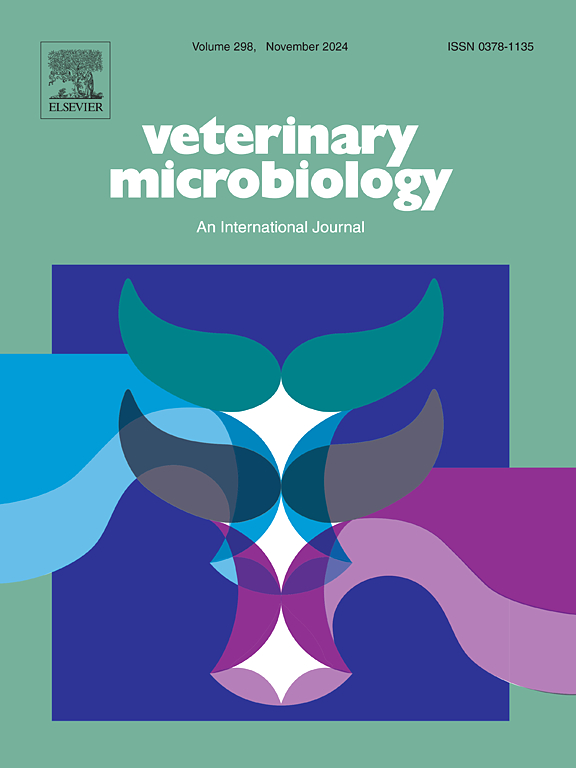Frequency and antimicrobial susceptibility profiles of bacterial species isolated from canine and feline urine samples in Sydney, Australia, 2012–2021
IF 2.4
2区 农林科学
Q3 MICROBIOLOGY
引用次数: 0
Abstract
Bacterial urinary tract infections are frequently diagnosed in veterinary practice and often treated empirically. Recommended treatment differs for sporadic versus recurrent infections. Antimicrobial selection is ideally informed by local antibiograms; however, this data is currently unavailable for dogs and cats in Sydney, Australia’s largest city by population. The objectives of this retrospective study were to: i) identify the proportions of bacterial species in positive cultures from canine and feline urine samples submitted between 2012 and 2021 to a veterinary diagnostic laboratory in Sydney, Australia, ii) describe and compare antimicrobial susceptibility profiles between isolates from sporadic and recurrent positive cultures and iii) develop local antibiograms to facilitate evidence-based decisions around empiric therapy. A total of 1506 positive urine cultures were obtained from 567 dogs and 471 cats. The most frequently isolated bacteria were Escherichia coli (58 %), Enterococcus spp. (17 %), Staphylococcus spp. (13.4 %) and Proteus spp. (9 %). Eighty-three percent of bacterial isolates were susceptible to at least one first-line empirical choice (amoxicillin and/or trimethoprim-sulfonamide). E. coli had the highest percentage of multidrug-resistant isolates from animals with sporadic (32 %) and recurrent positive cultures (40 %). Susceptibility of E. coli to amoxicillin increased from 47 % in 2012 to 55 % in 2021. Susceptibility of S. pseudintermedius to amoxicillin-clavulanic acid and oxacillin decreased from 100 % in 2012 to 54 % in 2021.Twenty-two percent of S. pseudintermedius isolates were methicillin-resistant. Compared to reports from other locations, our findings suggest that amoxicillin may be less effective as a first-line choice for treating canine and feline UTI in Sydney.
2012-2021年澳大利亚悉尼犬和猫尿液样本中细菌种类的频率和抗菌药物敏感性分析
细菌性尿路感染在兽医实践中经常被诊断出来,并经常以经验治疗。散发性感染和复发性感染的推荐治疗方法不同。理想情况下,抗菌药物的选择应根据当地抗生素图进行;然而,澳大利亚人口最多的城市悉尼的猫狗目前还没有这方面的数据。这项回顾性研究的目的是:1)确定2012年至2021年间提交给澳大利亚悉尼兽医诊断实验室的犬和猫尿液样本阳性培养物中细菌种类的比例;2)描述和比较散发阳性培养物和复发阳性培养物中分离物的抗生素敏感性特征;3)制定局部抗生素图,以促进循证治疗决策。567只狗和471只猫共获得1506例阳性尿液培养。检出最多的细菌为大肠杆菌(58. %)、肠球菌(17. %)、葡萄球菌(13.4% %)和变形杆菌(9. %)。83%的细菌分离株对至少一种一线经验选择(阿莫西林和/或甲氧苄啶-磺胺)敏感。从动物中分离出的多重耐药大肠杆菌比例最高,有散发(32% %)和反复阳性培养(40% %)。大肠杆菌对阿莫西林的敏感性从2012年的47 %增加到2021年的55 %。假中间链球菌对阿莫西林-克拉维酸和恶西林的敏感性由2012年的100 %下降到2021年的54 %。22%的假中间杆菌分离株对甲氧西林耐药。与其他地区的报告相比,我们的研究结果表明,阿莫西林作为治疗悉尼犬和猫尿路感染的一线选择可能效果较差。
本文章由计算机程序翻译,如有差异,请以英文原文为准。
求助全文
约1分钟内获得全文
求助全文
来源期刊

Veterinary microbiology
农林科学-兽医学
CiteScore
5.90
自引率
6.10%
发文量
221
审稿时长
52 days
期刊介绍:
Veterinary Microbiology is concerned with microbial (bacterial, fungal, viral) diseases of domesticated vertebrate animals (livestock, companion animals, fur-bearing animals, game, poultry, fish) that supply food, other useful products or companionship. In addition, Microbial diseases of wild animals living in captivity, or as members of the feral fauna will also be considered if the infections are of interest because of their interrelation with humans (zoonoses) and/or domestic animals. Studies of antimicrobial resistance are also included, provided that the results represent a substantial advance in knowledge. Authors are strongly encouraged to read - prior to submission - the Editorials (''Scope or cope'' and ''Scope or cope II'') published previously in the journal. The Editors reserve the right to suggest submission to another journal for those papers which they feel would be more appropriate for consideration by that journal.
Original research papers of high quality and novelty on aspects of control, host response, molecular biology, pathogenesis, prevention, and treatment of microbial diseases of animals are published. Papers dealing primarily with immunology, epidemiology, molecular biology and antiviral or microbial agents will only be considered if they demonstrate a clear impact on a disease. Papers focusing solely on diagnostic techniques (such as another PCR protocol or ELISA) will not be published - focus should be on a microorganism and not on a particular technique. Papers only reporting microbial sequences, transcriptomics data, or proteomics data will not be considered unless the results represent a substantial advance in knowledge.
Drug trial papers will be considered if they have general application or significance. Papers on the identification of microorganisms will also be considered, but detailed taxonomic studies do not fall within the scope of the journal. Case reports will not be published, unless they have general application or contain novel aspects. Papers of geographically limited interest, which repeat what had been established elsewhere will not be considered. The readership of the journal is global.
 求助内容:
求助内容: 应助结果提醒方式:
应助结果提醒方式:


